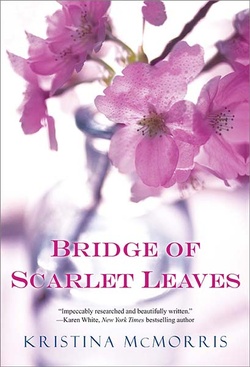In her second published novel, Bridge of Scarlet Leaves, Kristina McMorris displays her incredible talents as both a writer and historian. The author introduces readers to Maddie Kern, an accomplished violinist with aspirations of studying at Julliard. When Maddie falls in love with and eventually marries Lane Moritomo, a Japanese American and her brother’s best friend since childhood, their relationship is tested by the disapproval of their families, friends, and society in general.
After the bombing of Pearl Harbor, Japanese Americans are suddenly viewed with suspicion, hostility, and, in some cases, hateful violence, despite their citizenship as Americans. When Maddie and Lane reveal the romantic relationship that has innocently developed between them, their lives change forever. Author Kristina McMorris achieves a delicate balancing act of many characters—Maddie, Lane, TJ (Maddie’s brother), Emma and Kumiko (Lane’s sister and mother)—and accomplishes something remarkable: she makes each character significant, realistically human, and worthy of the reader’s care.
Unlike other stories that have been told about the incarceration of Japanese Americans during World War II, Bridge of Scarlet Leaves is particularly noteworthy because of the perspective from which the story is told—through the eyes of Maddie, a non-Japanese protagonist. When asked about her decision to create a story that is essentially about a Japanese American experience through the eyes of a non-Japanese character, Ms. McMorris elaborated on her decision. “When I first happened across the true account of non-Japanese spouses living in the relocation camps by choice, I was immediately attracted to the perspective for its uniqueness. I’d never heard of that happening, even as a Nisei myself, and ventured to guess the majority of other Americans hadn’t either. The other reason was, I felt mainstream readers could more easily identify with a Caucasian protagonist’s experience—essentially a fish-out-of-water story—versus trying to relate to a Japanese American point of view.”
Kristina McMorris was also able to draw from her own experiences when writing about some of the important issues the novel addresses. “As the daughter of a Japanese immigrant father and Caucasian American mother, I was raised living between two worlds. I remember, particularly during my high school years, wishing for blond hair and blue eyes. Not until later in life did I fully appreciate my differences. So this was the perspective that I relied on while following the journeys of my characters, who all find themselves on a search for their true identities.”
As a researcher, Ms. McMorris integrated important historical details into the fictional plotline—the bombing of Pearl Harbor, the executive order by President Roosevelt, the relocation of Japanese Americans, and their ongoing struggles after their release. With a plot that involves the relationships of different generations of Japanese Americans, she humanizes these historical events.
When asked about how the novel evolved, Kristina McMorris explained, “Many of the plot points in my novel definitely arose from true accounts I’d discovered during my research. For example, when I learned of Nisei men who, after becoming stranded in Japan after the attack on Pearl Harbor, were conscripted into the Imperial Army or Navy, I knew I had to find a way to weave that shocking piece of history into the book. I felt the same about children of Japanese descent who were torn from their traditional American families and sent to live in an orphanage at Manzanar War Relocation Camp.
Smaller-scaled tragedies also became very important to me, such as gas station attendants refusing service to Japanese American families that were attempting to evacuate from the West Coast voluntarily, or people stealing from Japanese American homes in broad daylight, confident that police wouldn’t be alerted. To me, these types of incidents bring history to a much more personal level than the broader concept of massive internment, which I think is harder to wrap our minds around today.” Readers of Bridge of Scarlet Leaves will find themselves educated about significant events during World War II and, at the same time, enlightened about the emotional toll these events took on Japanese Americans, their friends, soldiers, and even their adversaries. The novel will make readers sympathetic, angry, sad, indignant, and ultimately hopeful.
The title Bridge of Scarlet Leaves was inspired by a Japanese haiku. According to the author, “[the haiku] described standing on a famous bridge in Kyoto during momiji, meaning ‘leaf-viewing season,’ when all of the leaves in the valley turn vibrant red and gold. I felt the combination of words fit perfectly with my story, since a bridge not only closes the gap between cultures, hearts, and people, but in classical music—given that my protagonist is a violinist—it’s the transitional, reflective period prior to reaching the climax. As for leaves, which symbolize change, I envision them as scarlet at their most beautiful stage, right before they wither.”
In addition to the poetic allusion, the book’s title might also bring to mind the emotional bridges we must all confront in being human: the bridges that we struggle to build to connect with others; the bridges that we must cross to move forward from one point in life to another; and the bridges that we must create to forge essential bonds despite the cultural differences that sometimes separate us.
In many ways, the author herself has become a bridge between her writing and her readers. At the end of her book, she provides discussion questions for book groups and Asian-fusion recipes. “I absolutely love meeting with book clubs and schools in person and on the phone or through Skype. To schedule a visit, people are welcome to contact me through my website.” Ms. McMorris’s works of fiction, beginning with her debut novel, Letters from Home, have earned her more than twenty national literary awards and high critical acclaim.
Kristina McMorris will be visiting the Japanese American National Museum for two separate events. On May 12th, 2012, she will be part of a speakers’ panel, “Fact to Fiction: Asian Pacific Islander Authors Panel,” and on July 14th, 2012, she will be having her own author chat and signing for the paperback release of Bridge of Scarlet Leaves. She also has a novella, The Christmas Collector, which will be released late October in a holiday anthology titled A Winter Wonderland.
© 2012 Japanese American National Museum







